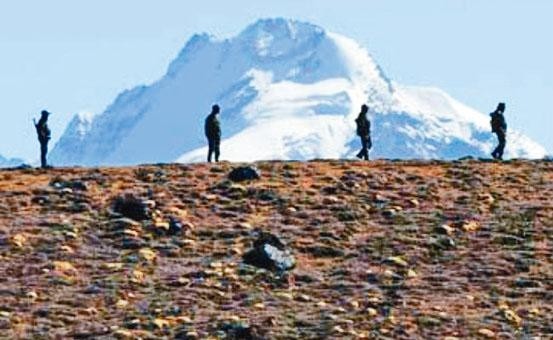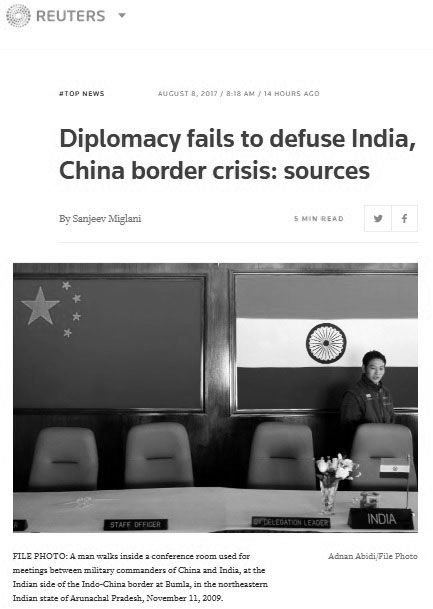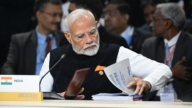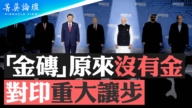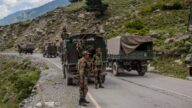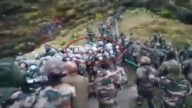【新唐人北京时间2017年08月10日讯】中印边境对峙已经持续一个多月,仍不见缓和。中共近日集中火力“声讨”印度,逼迫印方“无条件撤军”。但外媒消息称,中方曾一度答应后退100米换取印度撤军,但相关消息在大陆网络被删。
8月8日,路透社报导,同印度总理莫迪办公室关系密切的一名消息人士透露,印度要求中共军队从洞朗对峙前线后退250米,但中共没有回应。
报导称,在一场避开公众视线的秘密谈判中,中方人员一度表示同意后退100米,但需要请求最高层批准。不过,之后中方就没有了回音,印度等来的是北京一连串的警告。
另一个消息来源也表示,目前局势没有任何进展,双方陷入僵局。他担心对峙可能会拖延到下月在北京举行的金砖首脑会议。
路透社有关“中方曾同意退兵100米”的消息,很快在大陆网络上遭封禁,原因可能是与中共官方一再宣称的“印度无条件撤兵”立场相悖。(相关报导:央视主播转发共军洞朗后撤100米 微博被秒删)
中共近日对印度态度空前强硬,官媒8月7日甚至放出风声称,中共可能在两周内清场。
《美国之音》引述香港军事评论员马鼎盛的分析认为,所谓“清场”并不一定意味着开火,有可能只是用蛮力把印度军人强行驱离。因为一旦动武导致冲突升级,无论是北京还是新德里都不好收场。
路透社引述新德里中国问题学者 Srikanth Kondapalli 的分析称,双方发生军事冲突的几率很低,没有人认为习近平会在中共十九大之前开战。
8月7日,大陆网络一度传出中资企业从印度撤离的消息。中共官媒很快出面“辟谣”称,大规模撤侨并不存在,更不应被理解为是“备战行为”。随后,某的士司机被指“散布谣言”,遭警方拘留。
《印度时报》8月7日报导,在对峙地点中印双方各有约300—350人。在其背后,印度在甘托克、宾那古里和卡林朋各部署一个山地师,每个师有约1万兵力。而中方在后方驻军分三个层次,只有1,500兵力。
印度军方称,双方近两个月来从未向边境增兵。
外界分析,中印双方看似剑拔弩张,实际上都不想爆发战争,其“交战战场”仅限于媒体和外交场合。
以下为路透社报导原文:
NEW DELHI (Reuters) – India’s diplomatic efforts to end a seven-week military standoff with China have hit a roadblock, people briefed on the talks said, prompting Chinese state-run media to trumpet rhetoric of “unavoidable countermeasures" on the unmarked border.
China has insisted that India unilaterally withdraw its troops from the remote Doklam plateau claimed by both Beijing and Indian ally Bhutan.
(For a graphic on China-India border dispute click tmsnrt.rs/2wnxWuV)
But China did not respond to India’s suggestion in the talks that it move its troops back 250 meters (820 ft) in return, said one source with close ties to Prime Minister Narendra Modi’s government.
In the low-key diplomatic maneuvers that took place outside the public eye, the Chinese countered with an offer to move back 100 meters (328 ft), so long as they received clearance from top government officials.
But there has been no comeback since, except for China’s mounting warnings of an escalation in the region, which it calls Donglang.
“It is a logjam, there is no movement at all now," said a second source with knowledge of the talks.
In Beijing, China’s Foreign Ministry said the country would never give up any territory.
“Under no circumstances will China make its own territorial sovereignty a term of exchange," it said in a statement sent to Reuters when asked about the talks, reiterating that India had to unconditionally withdraw its forces.
Indian troops went into Doklam in mid-June to stop a Chinese construction crew from extending a road India’s military says will bring China’s army too close for comfort in the northeast.
Their faceoff since, military experts say, is the most serious since going toe-to-toe in the 1980s, with thousands of soldiers each, elsewhere along the 3,500-km (2,175-mile) border.
China has held off going to war in the hope New Delhi would see reason, the state-run Global Times, which has kept up a barrage of hostile commentary, said on Tuesday.
“If the Narendra Modi government continues ignoring the warning coming from a situation spiraling out of control, countermeasures from China will be unavoidable," it said.
The border crisis caps a year of souring diplomatic ties between the Asian giants, even though trade between the fast growing economies is rising rapidly.
India has grown concerned at China’s ties to its arch rival Pakistan, viewing their trade corridor across Kashmir as an infringement of its claim to the whole of the region.
Modi refused to join President Xi Jinping’s signature Belt and Road initiative to knit together Asia and beyond, making India the lone country to boycott a summit in May.
China has warned New Delhi not to be drawn into a Western military alliance led by the United States and including Japan. Modi has sought closer ties with both.
“There will be no happy ending for this confrontation," Indian foreign policy expert C. Raja Mohan wrote in the Indian Express newspaper, adding that India was unlikely to give in.
The second source said the worry was the standoff could drag on into a summit of BRICs nations China is hosting next month.
LIVE MANEUVERS
Indian military officials say there is no troop buildup on either side, nearly two months into a standoff that involved about 300 soldiers just 100 meters (328 ft) apart on a plateau 3,000 m (10,000 ft) above sea level.
China has accused India of massing troops, however, and state media have warned against a fate worse than its defeat in a brief border war in 1962.
“We will keep engaging with China to resolve the dispute. War cannot solve problems," Indian Foreign Minister Sushma Swaraj told parliament, sticking to a conciliatory stance.
Still, both have flexed their muscles.
Last month, China held live-fire drills on the Qinghai-Tibet Plateau near the site of the standoff, state media said.
India’s army ran low-key exercises in the Ladakh sector of the western Himalayas, where previous disputes have flared, though it is thousands of miles distant from Doklam.
“The chance of a conflict is low, nobody is expecting Xi Jinping to go to war before the Communist Party’s congress," said Srikanth Kondapalli, a China specialist at Jawaharlal Nehru University in New Delhi, referring to an Oct-Nov meeting expected to confirm a second five-year term as party general secretary for the Chinese leader.
(记者桓宇报导/责任编辑:唐睿)


